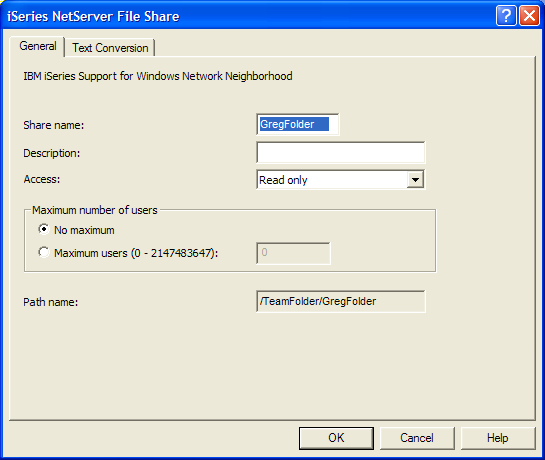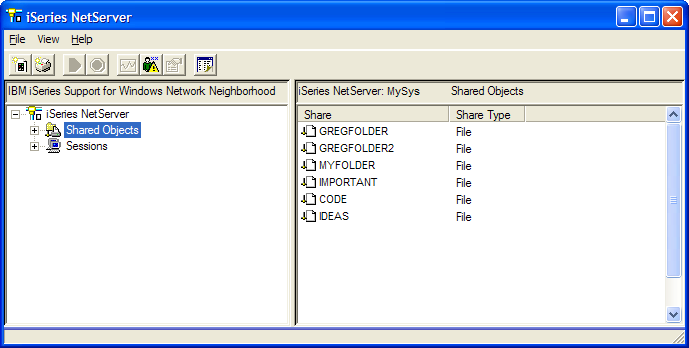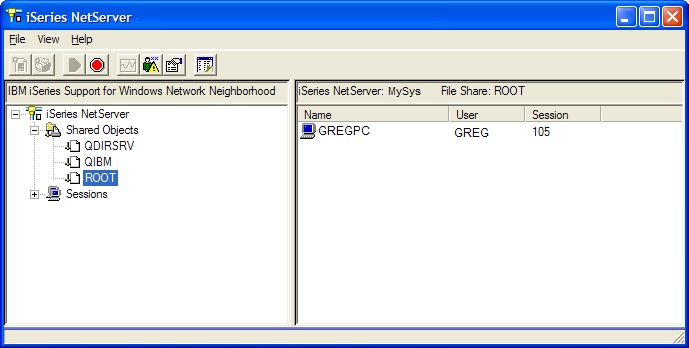When I speak with users about iSeries Navigator's IFS function, they are often surprised to find out about one easy-to-use function that they didn't know even existed. In this tip, I'll talk about sharing a folder and ways you can take advantage of it.
Share a Folder and Its Data
The concept is simple enough. You have a folder in the IFS on your iSeries and you want to access that folder from your desktop PC. The steps to share a folder are simple enough as well.
First, open iSeries Navigator. Sign onto your favorite iSeries system and navigate to the File Systems folder. Open the Integrated File System folder and navigate to the folder you want to access from your PC. Right-click on that folder and select Sharing -> New Share. The dialog that comes up will default settings like the name of the share and the default access rights (Figure 1). Select the defaults and click OK, and you're all set.

Figure 1: Select the default settings and click OK. (Click images to enlarge.)
Now, simply open your PC search function to find the computer (your iSeries name), and your shared folder will appear under the computer name. Another option is to simply type the directory path: Systemnamefilename.extension.
For example, if you share a folder off the root directory on System1, it would be System1 ootmyfolder, but if you share a library off of QSYS, then the path would be System1qsys.libmylib.lib. See the extensions? I know it's confusing, but that's the life of mixing QSYS and IFS objects.
The name listed above is the name of the file share, which can be different from the folder name. It's important to know that a file share is an object all its own (we call it a "file system shared object"). It can be added, removed, even have permissions assigned to it. In fact, a single folder can have multiple file shares created. They all point to the same folder, but they have different names and potentially different access settings. The important difference is that you can set up different permissions on each file share to control who can have access to the folder. For example, I could set up GregFolder and FredFolder as file shares. GregFolder could provide read-only access, whereas FredFolder could provide read/write access. Further, each file share's permissions could be set up so that only user profiles Greg1, Greg2, and Greg3 can access file share GregFolder, whereas all user profiles in group THEFREDS (all profiles named with FRED) can use FredFolder.
How do you set unique permissions on a file share? It's not all that straightforward. You'd think all you would do is select the file share from the File Shares folder, but that would be too simple. Instead, you have to right-click on the File Shares folder, select the Open iSeries NetServer menu, and find your share name in the iSeries NetServer window (Figure 2). Right-click on the share name and select Permissions. From here, you can add users or user groups. You can also select an authorization list that will be used to secure the file share. This is recommended because authorization lists can then be managed by function or type of user, and once a user and object is added to an authorization list, you can clearly see who can use that object.

Figure 2: Set unique permissions on a file share.
One other nice feature is that you can view which PCs are currently connected to a shared object. Simply click on the file share in the left tree, and the PCs currently connected will show up in the right (see Figure 3).
Figure 3: View which PCs are connected to a shared object.
Besides the normal "network drive access" benefits that come with sharing a folder, you can use functions like InfoPrint Server, which allows you to create PDF files from printer output and put the created PDF into an IFS folder. This is great because you can set your boss up with the I: drive that points to the iSeries, and when a new report comes in, just click "Convert to PDF" and put it in the folder that's shared. Simple! Or you could share a folder for a tester, and when he encounters a problem, he can dump any job log data or command output to this shared folder so that the developer doesn't even have to sign onto the iSeries.
Learning to Share
I hope this tip is useful to you. I know that this little-know function is very useful to me. For more information on IFS and iSeries Navigator, visit the following Web sites:
- iSeries Navigator: www.ibm.com/eserver/iseries/navigator
- IBM Information Center: www.ibm.com/eserver/iseries/infocenter
Greg Hintermeister is a user interface designer at IBM. He has extensive experience designing user interfaces for iSeries Navigator, the IBM Virtualization Engine, wireless applications, and numerous Web applications. Greg is a regular speaker at user groups and technical conferences. You can email him at













 Business users want new applications now. Market and regulatory pressures require faster application updates and delivery into production. Your IBM i developers may be approaching retirement, and you see no sure way to fill their positions with experienced developers. In addition, you may be caught between maintaining your existing applications and the uncertainty of moving to something new.
Business users want new applications now. Market and regulatory pressures require faster application updates and delivery into production. Your IBM i developers may be approaching retirement, and you see no sure way to fill their positions with experienced developers. In addition, you may be caught between maintaining your existing applications and the uncertainty of moving to something new. IT managers hoping to find new IBM i talent are discovering that the pool of experienced RPG programmers and operators or administrators with intimate knowledge of the operating system and the applications that run on it is small. This begs the question: How will you manage the platform that supports such a big part of your business? This guide offers strategies and software suggestions to help you plan IT staffing and resources and smooth the transition after your AS/400 talent retires. Read on to learn:
IT managers hoping to find new IBM i talent are discovering that the pool of experienced RPG programmers and operators or administrators with intimate knowledge of the operating system and the applications that run on it is small. This begs the question: How will you manage the platform that supports such a big part of your business? This guide offers strategies and software suggestions to help you plan IT staffing and resources and smooth the transition after your AS/400 talent retires. Read on to learn:
LATEST COMMENTS
MC Press Online